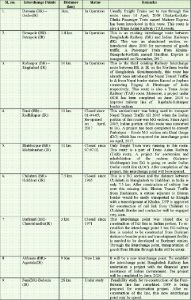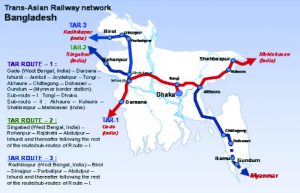Connectivity with neighboring countries through transportation (i.e. rail, road etc.) will help to integrate the economy of connected countries and promote economic development by sharing of resources. Bangladesh Railway (BR) and Indian Railway (IR) are historically connected. Both the Railways inherit the respective railway network from the then British Government.
Status of railway connectivity with India
There is existence of 7 interchange points that connect Bangladesh Railway (BR) network with Indian Railway (IR). Out of these 7 interchange points, only 4 are in operation now. Also, initiatives have been taken to establish 2 more interchange points. Detail status of the interchange points are described below –
Present bilateral arrangement for connectivity
Railway agreement between Bangl-adesh and India: At present Bangladesh Railway has agreement with Indian Railway for conducting railway services between Benapole (Bangladesh)-Petrapole (India), Darsana (Bangladesh)- Gede, Rohanpur-Singhabad and Birol (Bangladesh) – Radhikapur (India) interchange points. For the operation of other interchange points new agreement may be executed between BR and IR.
Railway agreement between Bangl-adesh and Nepal: Bangladesh has an agreement with India to facilitate overland traffic between Bangladesh and Nepal. Presently Singhabad (India) – Rohanpur (Bangladesh) interchange point is used for “Traffic in Transit” to/from Nepal and Bangladesh. After conversion of Birol-Birol border section into BG from MG and Parbatipur – Birol section into DG from MG, Birol-Radhikapur interchange point is being used for “Traffic in Transit” to/from Nepal and Bangladesh.
Railway agreement between Bang-ladesh and Bhutan: Presently Bangladesh Railway does not have any agreement with Bhutan. However, a reference in Para 22 of Strategic Framework for Trade Facilitation for the SASEC Program 2014-2018 of SASEC indicated Bhutan’s eagerness for having a transit agreement with Bangladesh. In this context, the Commerce Ministry has been requested to include the two rail routes i.e. Chilahati (Bangladesh) – Haldibari (india) & Burimari (Bangladesh) – Chengrabandha (india) in the Draft Agreement on Transit between Bhutan & Bangladesh.
Railway agreement between Bang-ladesh and Mayanmar: Bangladesh Railway has no railway link with Mayanmar. But Mayanmar is one of the signatory countries of Trans Asian Railway (TAR) route. One of the proposed TAR routes will exit through Myanmar. Bangladesh Railway is constructing Dohazari to Cox’s bazar railway link project via Ramu. In future to establish the TAR route Bangladesh Railway will construct railway line from Ramu to Gundum at Mayanmar boarder.
Regional arrangements for connectivity
Proposed Trans Asian Railway (TAR) Routes in Bangladesh
Bangladesh has signed the “Intergovernmental Agreement on the Trans-Asian Railway (TAR) Network” as 20th signatory on 09-11-2007. Three proposed Trans-Asian Railway (TAR) route enters Bangladesh from three directions from the Indian state of West Bengal i.e. Gede, Singabad and Radhikapur and exits through Gundum-Myanmar or Shahbajpur-Mahishosan, India.
TAR Route – 1
Gede (West Bengal, India)-Darsana-Ishurdi-Jamtoil-Joydebpur-Tongi-Akhaura-Chittagong-Dohazari-Gundum(Myanmar border station).
Sub-route – I: Tongi – Dhaka.
Sub-route-II: Akhaura-Kulaura-Shah-bazpur-Mahishasan (India)
TAR Rpoute – 2
Singabad (West Bengal, India)-Rohanpur- Rajshahi-Abdulpur-Ishurdi and thereafter following the rest of the route/sub-routes of Route -1.
TAR Route – 3
Radhikapur (West Bengal, India)-Birol-Dinajpur-Parbatipur-Abdulpur-Ishurdi and thereafter following the rest of the route/sub-routes of Route – 1.
Attempts taken by SAARC for regional railway connectivity
The SAARC Regional Multimodal Transport Study (SRMTS), financed by Asian Development Bank (ADB) initially identified 5 (five) regional railway routes. Subsequently another route was identified and thus total route became 6. Among the total 6 (six) regional railway routes, the following 3 (three) routes passed through Bangladesh:
SAARC Route-1: Lahore (Pakistan)- Delhi (India)- Kolkata- Dhaka- Akhaura- Kulaura-Shahbajpur- Mohishashon- Imphal.
SAARC Route-4: Birgunj (Nepal)- Raxaul (India)- Katihar- Singhabad (India)-Rohanpur (Bangladesh)- Rajshahi- Abdulpur-Ishurdi- (transhipment)- Ctg. Port and reverse with links to Jogbani-Biratnagar- Akhaura-Agartala.
SAARC Route-6: Birgunj (Nepal)- Raxual (India)- Singhabad (India)- Rohanpur (Bangladesh)- Rajshahi-Abdulpur-Ishurdi- Khulna-Mongla and reverse with links to Jogbani- Biratnagar.
Attempts taken by BIMSTEC for regional railway connectivity
A study titled “BIMSTEC Transport Infrastructure and Logistic Study (BTILS)” was carried out in 2007 under the finance of Asian Development Bank (ADB). The study identified total 4(four) regional railway routes out of which the following 2 (two) routes pass through Bangladesh:
BTILS Route-1: Lahore(Pakistan)- Delhi/Kolkata(India)- Dhaka/Kulaura (Bangladesh)-Mohishashon-Imphal (India).
BTILS Route-3: Birgunj(Nepal)-Katihar/Singhabad(India)-Rohanpur (Bangladesh)-Chittagong Port with links to Jogbani, Biratnagar (Nepal) and Agartala (India).
- Issues to be addressed to improve the connectivity-
- There should be an agreement among the SAARC member countries to eliminate the restrictions of movement of trains in the territory of member countries.
- Physical barrier to implement the railway corridors proposed by SRMTS, BTILS, and TAR should be eliminated by implementing necessary projects.
- New bilateral or multilateral corridors should be explored for mutual benefit.
- New bilateral or multilateral agreements are needed to be executed from running of trains in the neighboring countries.
- Member countries and Development Partners should come forward to finance the necessary projects needed for establishment of connectivity.












